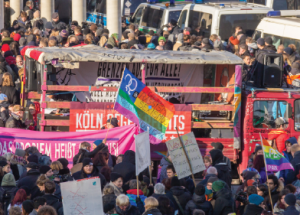Rethinking the On-Going Refugee Crisis: Listening to Refugees as Key Stakeholders
Rethinking the On-Going Refugee Crisis: Listening to Refugees as Key Stakeholders
 Almost one year ago, I co-authored a position paper for the Peace and Justice Studies Association (PJSA) titled International Migration and Refugee Crisis Intervention, in which a colleague and I argued that developed countries “have a collective moral responsibility to enact a comprehensive and coordinated refugee and migration response” to the Syrian refugee crisis.[1] Unfortunately, over the last year the refugee “crisis” has subsided only slightly and refugee coordination has improved very little. [2] While I still argue that it is “not the time to close borders, but to open dialogue about fair and just international refugee migration and support services,”[3] I believe that such dialogue cannot be effective unless refugees themselves are at the center of any such dialogue process. For too long, decision-makers concerned about immigrant and refugee issues have sidelined those that are directly affected by these issues. Unless those working on migration and refugee issues hear the convoluted and traumatic stories of refugees' experiences, they will continue to drive policy decisions that act as only stop—gap measures in dealing with the complex social issues affecting global migration.
Almost one year ago, I co-authored a position paper for the Peace and Justice Studies Association (PJSA) titled International Migration and Refugee Crisis Intervention, in which a colleague and I argued that developed countries “have a collective moral responsibility to enact a comprehensive and coordinated refugee and migration response” to the Syrian refugee crisis.[1] Unfortunately, over the last year the refugee “crisis” has subsided only slightly and refugee coordination has improved very little. [2] While I still argue that it is “not the time to close borders, but to open dialogue about fair and just international refugee migration and support services,”[3] I believe that such dialogue cannot be effective unless refugees themselves are at the center of any such dialogue process. For too long, decision-makers concerned about immigrant and refugee issues have sidelined those that are directly affected by these issues. Unless those working on migration and refugee issues hear the convoluted and traumatic stories of refugees' experiences, they will continue to drive policy decisions that act as only stop—gap measures in dealing with the complex social issues affecting global migration.
According to the UNHCR, the United Nations' lead Refugee Agency, there are an estimated 65.3 million forcibly displaced persons in the world today. [4] As a result of primarily violent conflict, human rights abuses, and persecution, approximately 34,000 people worldwide were forced to leave their homes each day of 2016.[5] Many of these were internally displaced persons (IDPs[6]), but once they leave their country of citizenship they become refugees. The plight of refugees is more difficult than most of us can imagine. Sleeping outdoors, risking life and limb to be smuggled across borders, and being constantly vulnerable to crime and human trafficking, refugees not only flee dangerous situations, but live through them as they attempt to start a new life in often distant lands. Refugees are among the most vulnerable populations in any country, and with anti-immigrant sentiment on the rise around the world, 2017 does not bode well for the world’s refugees.
While the recent Syrian refugee crisis, the largest refugee crisis the world has seen since World War II, has exposed critical cracks in the coordinated intervention of many Western developed economies, many responses to this human tragedy continue to discount the needs of refugees themselves. Most refugees would rather never leave their home countries, but circumstances in their homes have forced them to make the weighty decision to risk undocumented travels and extreme hardships to pursue the distant hope of peace and security. Still, internal needs of states for security often clashes with refugees need for safety. The result of this clash is often that refugee safety falls victim to states desire for controlled borders and human security. So how might developed countries most effectively and inexpensively deal with this ongoing issue of refugees? I believe the answer involves listening to refugees’ experiences instead of the fears and rhetoric of xenophobic citizens or politicians’ code-switching arguments about national security.[7]
While the gaps in providing international refugees safe passage and support as they flee both environmental and man-made catastrophe worldwide represent a major challenge for state governments in more ‘developed’ countries, they also represent an opportunity to develop empathy and understanding for the complexities of the refugee experience. [8] The fact is that refugees are more a boon than a draw on the economies to which they flee. In fact, a recent International Monetary Fund (IMF) report argued that both “the inflow of asylum seekers is likely to have an immediate expansionary effect on the economy” and “displacement effects on native workers—a major political concern—are likely to be short-lived and small.”[9]
Developed countries not only have a collective moral responsibility to enact a comprehensive and coordinated refugee and migration response, but also a pragmatic humanitarian responsibility to work to lessen the suffering that results from the violence, instability, and trauma involuntarily experienced by international refugee populations worldwide. The safety and citizenship needs of a growing international refugee population must be systematically addressed by joint-collaborative action of state and non-state actors working off a set of international best practices for supporting, protecting, and resettling refugee communities. This cannot be done without direct connection to the refugees themselves. Each refugee has a unique story that develops a mosaic understanding of regional political histories of power.
Some 86 percent of the world’s refugees reside in developing countries and over half (51 percent) are under the age of 18—the highest percentage in a decade. The social, political, and economic ramifications of these massive flows of young and largely able-bodied refugees requires well-reasoned and well-coordinated response, and response that meets the needs of refugees can and should be response that meets the needs of host country nationals. These young workers can and should be used in the aging populations of Europe and America. This could be a win-win with refugees being given a start to build a new life, and the economies they immigrate to benefiting from their rich skills and experience. Such a refugee-centered rethinking of the refugee crisis, might just turn it into the greatest human development success of our young century.
### This article is not for citation without the author's permission.
_______________________________
[2]Dunn, Elizabeth Cullen. “Refugee protection and resettlement problems” Science 13 May 2016:Vol. 352, Issue 6287, pp. 772-773.
[3]PJSA, “International Migration” Position paper, op. cit.
[4]See http://www.unhcr.org/en-us/figures-at-a-glance.html- accessed January 9, 2017.
[5]UNHCR “Figures at a glance,” op. cit.
[6]Those who are forced to leave their homes for protection inside their country are known as internally displaced persons (IDPs). Syria, Columbia, Mali, Afghanistan, Iraq, South Sudan, the Democratic Republic of Congo, and the Central African Republic are home to most of the world’s IDPs (Facts and figures about refugees. (n.d.). UNHCR. Retrieved November 5, 2015 from http://www.unhcr.org.uk/about-us/key-facts-and-figures.html).
[7]In late 2016, in the wake of the Paris terrorist attacks, many politicians raised concerns about the refugee vetting process. In response the Obama White House issued a clear description of the “rigorous” vetting process (see https://www.whitehouse.gov/blog/2015/11/20/infographic-screening-process-refugee-entry-united-states), which is much more difficult than processes for obtaining tourist or business visas to the United States.
[8]For good first person accounts of refugee experiences see: http://www.pbssocal.org/programs/frontline/exodus/
[9]“The Refugee Surge in Europe: Economic Challenges” SDN/16/02 (January 2016), p. 32-33 - http://www.imf.org/external/pubs/ft/sdn/2016/sdn1602.pdf- Accessed January 9, 2017.




